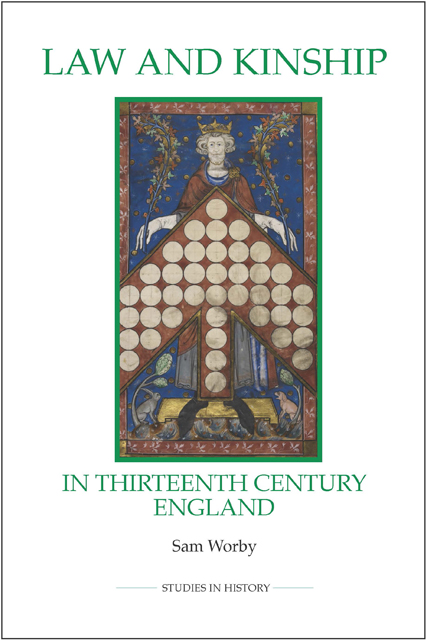Book contents
- Frontmatter
- Contents
- List of illustrations
- List of tables
- Acknowledgements
- Abbreviations
- Introduction
- 1 Canon law kinship structures
- 2 Common law kinship structures
- 3 The dominance of canon law kinship ideas
- 4 Kinship laws in practice
- 5 Trends underlying legal kinship structures
- Conclusion
- Appendices
- Bibliography
- Index
3 - Common law adaptations of canon law treatises: Quibus modis
Published online by Cambridge University Press: 01 March 2023
- Frontmatter
- Contents
- List of illustrations
- List of tables
- Acknowledgements
- Abbreviations
- Introduction
- 1 Canon law kinship structures
- 2 Common law kinship structures
- 3 The dominance of canon law kinship ideas
- 4 Kinship laws in practice
- 5 Trends underlying legal kinship structures
- Conclusion
- Appendices
- Bibliography
- Index
Summary
This is a transcription of Quibus modis , an adaptation of Johannes Egitaniensis's Lecturaon the trees of consanguinity and affinity which was made by common lawyers probably around the end of the thirteenth century. The adapted treatise occurs in two Bractonmanuscripts, BL, MS Harley 653, fos 40v–41r, and Worcester Cathedral Library, MS F 87, fos 28v-29r. This transcription is based on the Harley manuscript (H) , compared against the Worcester manuscript (W)and an edition (E)of the full original treatise by Johannes Egitaniensis: ‘Lectura arborum consanguinitatis et affinitatis Magistri Ioannis Egitaniensis’, ed. I. da Rosa Pereira, Studia Gratianxiv, Collectanea Stephan Kuttner iv (1967), 155–82.
1 ‘Quibus modis arbor de consanguinitate debet fieri’
2 In medio videlicet arboris fiat quedam cellula, que truncus vel protheus appellatur.
3 Protende ergo a vertice prothei sive trunci sursum lineam ascendentem continentem quatuor cellulas, in quarum prima pater et mater ponantur; in secunda avus et avia; in tertia proavus et proavia; in quarta abavus, abavia.
4 Similiter describe lineam descendentem a protheo continentem quatuor cellulas, in quarum prima ponantur filius et filia; in secunda nepos, neptis; in tertia pronepos, proneptis; in quarta abnepos, abneptis.
5 Restat igitur videre de lineis transversalibus, quarum due linee oriuntur a protheo, immo a patre prothei, et a quolibet suo superiori; oritur una linea tam ex patre quam ex matre.
6 Ex inferioribus, scilicet ab inferiori linea directa descendenti, nulla oritur transversalis, quia omnes qui ab inferioribus descendunt recta via descendunt a protheo.
7 Pone ergo tam iuxta protheum quam quemlibet superiorem fratrem et sororem, designans eos illis nominibus relativis quibus referuntur ad protheum, et illos liga cum incausto ad designandum quod faciunt unum gradum.
8 Deinde singulis eorum assigna filios et nepotes usque ad quartum gradum respectu prothei, et sic includes consanguinitatem usque ad quartum gradum.
9 Et medietas arboris sufficeret in doctrina tradenda, ut staret ad modum vexilli; sed alia medietas vel fuit posita ad decorem vel ut scirentur nomina consanguinitatis tam ex parte masculini quam ex parte feminina.
10 Et nota ex precedentibus quod quinque sunt linee: prima est descendens directa; secunda est ascendens directa; tertia est linea equalitatis; quarta transversalis superequalis; quinta transversalis subequalis.
- Type
- Chapter
- Information
- Law and Kinship in Thirteenth-Century England , pp. 167 - 174Publisher: Boydell & BrewerPrint publication year: 2010

